| |
|
| |
Usually, no one notices when I walk into the Bakehouse. I’m just another quiet, older lady with her coffee. Today, a tall, dark Tanzanian with shoulder-length dreadlocks strides through the door. When he gives me a standing hug, people look up from their laptops, trying not to stare.
Walter Miya, the tour director of Safari Arts Expeditions is eager to snag me as a client. I’m also keen to join his safari, yet not sure I can afford even a budget-level tour. |
|
|
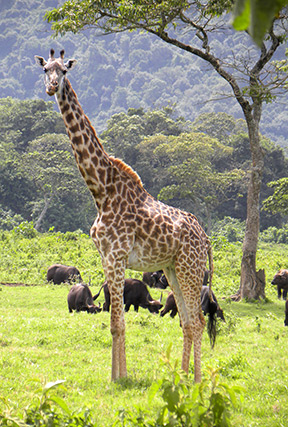 |
|
Walter on safari sits beside a striped Maasai blanket |
|
|
Giraffe seems curious about human beings with cameras in the jeep |
|
| |
 |
|
Soon Billy Giles, Walter’s long-time client and friend, pulls up a chair. An easy- going guy with bushy, white hair, Billy traveled with Walter two years before. Walter and Billy are leaders, the alpha and beta males in my new social group. Quick-witted and kind, they’d be fun to travel with, yet I hardly know them. Walter believes camping is the best way to see the animals. I’m not at all sure I can cope with camping, so I joke with him.
“Will a butler bring drinks to my tent every night?" I ask. "I don’t really expect this service, but the airy chatter helps cover my fears."
After a previous camping experience (27 years before). I decided I was too old for camping. On a guided Maori trek through a New Zealand rain forest, I hiked all day. At night in the cold tent, I could hardly sleep on the hard ground.Walter picks up on my hesitation, and quickly reassures me. “After we put cognac in your bottled water, you’ll sleep like a baby!” |
|
| |
Tour director Walter Miya pitches in to help the staff |
|
|
|
| |
Tactfully, Walter asks Billy whether I might join the safari that he and his family have planned. We all work out an affordable price, and I’m thrilled! I then tell Walter I want to go dancing in Africa. Since this request comes from a 77-year-old woman who’s joking around, I’m not sure he takes my request seriously.
Helpfully, Walter follows me to the travel agency. Again, heads look up from the computers as we climb the stairs, as if I were trailed by an exotic pet.
Travel agent Tami Wampler is tapping rapidly on a keyboard with sharp, fuschia fingernails. Planning my two-month journey is a challenge. She links flights to/from Indianapolis, Dulles, Addis Ababa, Nairobi, Lusaka, Harare and Lilongwe. When my focus on this complexity lapses, I give Tami the right date in the wrong month for the flight back home. |
|
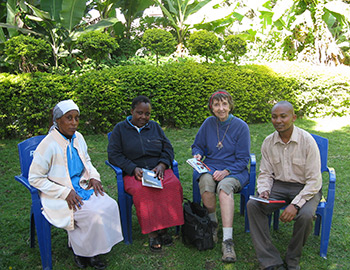 |
|
| |
Fortunately, Walter catches the error before she sends it to the printer. When Tami comes around us to pick up the print-out, she reaches out toward Walter.
“Just couldn’t wait to touch your hair!” she explains. |
|
While visiting libraries for KILEO, Sally McKinney meets with library staff in Arusha. Photo credit Billy Giles.
|
|
| |
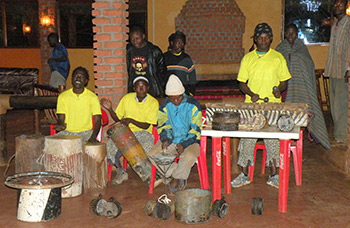
|
|
Walter’s early life was a shaky journey over rough African roads. The only child of a single parent, Walter “grew up poor” but learned to share what he had, whether it was pencils, notebooks, jackets or food.
As a teenager, Walter worked on the streets, rounding up clients for Tanzania tour companies. Working as a ranger in Arusha National Park, he learned to talk on the radio, chase down poachers, and guide park visitors on Mt. Meru climbs. |
|
| |
A visiting Makonde (tribe) band performs at the campground on last night of safari.
Photo credit Alice Fagin |
|
|
|
| |
When the American woman, who would eventually become his wife, met Walter, he was her guide on a Mt. Meru climb.
“He looked so cool,” Shawn Miya recalls. She had forgotten she had to pay the Arusha National park fee in U.S. dollars. When Walter realized her distress, he went out of his way to help convert the Tanzania shillings.
“If it wasn’t for Walter, I couldn’t have climbed that day,” Shawn says. |
|
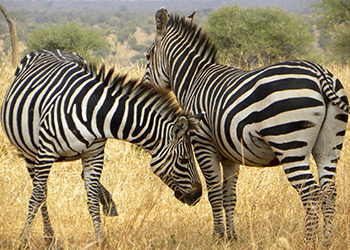
|
|
| |
|
|
A pair of zebras gets better acquainted |
|
| |
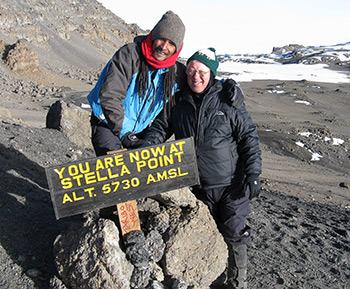
|
|
Left: Best buddies Billy Giles and Walter Miya climb Mt. Kilimanjaro a second time. Photo credit Billy Giles (i.e. someone held Billy's camera).
During their four days on Africa’s second-highest mountain, the couple discovered they had much in common. Whenever they talked, Shawn was impressed by Walter’s knowledge of plants and animals. She recalls learning that the little dik- diks mate for life. She remembers that they stayed up late talking one night, despite the high-altitude cold. On the way down the mountain, Walter held her hand, helping to steady her on slippery parts of the trail. |
|
| |
Best buddies Billy Giles and Walter Miya climb Mt. Kilimanjaro a second time. Photo credit Billy Giles (i.e. someone held Billy's camera). |
|
A pair of zebras gets better acquainted |
|
| |
Walter was surprised to learn he had a half-brother named Roy. In order to meet him, Walter knocked unexpectedly on Roy’s front door. When they compared their lives, they learned they’d both been working in Tanzania national parks. Realizing the value of this experience, together, they launched Safari Arts Expeditions (www.safariartsexpeditions.com).
“I think I was in love with him by the time we came down,” Shawn confides. Shawn and Walter believed it wise to become better acquainted over time.
Walter was surprised to learn he had a half-brother named Roy. In order to meet him, Walter knocked unexpectedly on Roy’s front door. When they compared their lives, they learned they’d both been working in Tanzania national parks. Realizing the value of this experience, together, they launched Safari Arts Expeditions (www.safariartsexpeditions.com). |
|
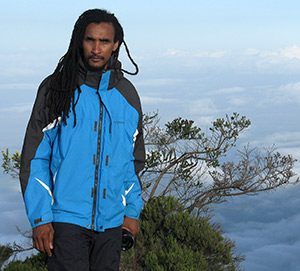
|
|
| |
|
|
Walter Miya once more guides people on a tough climb. Photo credit Billy Giles |
|
| |
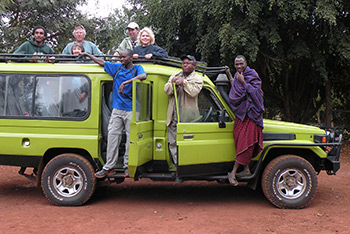
|
|
Shawn and Walter were married in Dar es Salaam, settled in southern Indiana, and had two children, Zion and Aikaeli. In order to increase educational opportunities in Tanzania, the couple formed the non-profit Kilimanjaro Education Outreach (a.k.a. KILEO www.kileo.org ). In 2010, they organized the first annual Taste of East Africa benefit. In early 2012, Shawn and Walter sold most of what they owned, crammed the rest into 12 suitcases, then flew from Indiana to Tanzania to settle there with their children, Zion and Aikaeli.
When I arrive in Tanzania in May, 2011, Walter Miya’s family shows me warm hospitality. In Dar es Salaam, Arusha, Marangu and Mwanza, I sleep on the family’s fanciest sheets in their air-cooled guest rooms. Someone rises early to boil water, then mix it with cool so I can use pails of this to bathe. Between meals, my hosts offer me cold drinks or snacks, a piece of ripe fruit. |
|
| |
Safari group hangs onto the jeep on last morning at the campground. Photo credit Alice Fagin (i.e.was taken with her camera) |
|
|
|
| |
In Mwanza, while staying with Joanne and Martin Miya, my worries about camping fall away. Walter’s father assures me that Walter’s staff will put up the safari tents, also buy, cook and serve the food. All I’ll have to do is sleep, eat and ride around in a jeep, snapping pictures. How hard can it be?
When the safari jeep pulls into the campground in Serengeti National Park, I notice that the tents are sitting on close-cropped grass. At least I’ll be able to see (and run from) any snakes, my greatest fear. Before coming to Africa, I’d seen zebras, giraffes, baboons, ostriches and lions only in zoos. Here, we are intruders in a wild place without fences where the animals roam and hunt for food.
Billy and Walter had a nocturnal visitor on safari two years before. While they were trying to sleep, a noisy hyena showed up to forage for food, rattling anything not tied down. Before we sleep, Walter instructs us to rise early for a game drive. Just before dawn, I awake to chirping birds. No hyenas in sight. The sky is a vacuous gray. Beyond the campground, in the grassy savanna, wild African buffalo are lowing like cattle. |
|

|
|
| |
|
|
Billy Giles uses a borrowed guide book to identify a bird |
|
| |
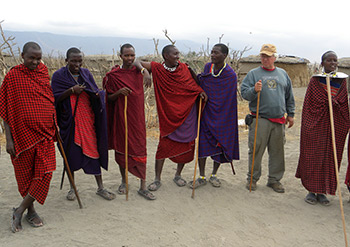
|
|
Walter looks tired. He’s standing, staring into the distance, outside his tent, and I realize he’s been working long hours. Each day, he manages the safari operation, loading and unloading equipment and food. We move from one park to the next. Each night, he takes my camera battery and charger to any electric outlet he can find. Each morning, he returns my equipment with the battery fully charged.
On my first morning in Serengeti, we bounce along one of Tanzania’s roughest roads. Barely awake and craving a second coffee, I gaze out the open window. A rosy, crescent sun—unreal—seems to float behind an acacia tree. We spot a gawky giraffe looking back at us. Driver Charles Msaky points to a leopard resting on a branch, half-hidden in dappled shade. Through the windscreen I watch, elephants cross the road in single file, as if practicing for a parade. |
|
| |
Billy Giles joins the men in their dance line at Maasai boma. |
|
Billy Giles uses a borrowed guide book to identify a bird |
|
Soon I know why we left camp so early. Using impressive tracking skills, Walter and Charles discover a pride of lions. I feel privileged to watch female lions and cubs as they splash in a pond, lapping up water. Perhaps aware of cheetahs on the horizon, the lions hide the cubs behind a screen of tall grass clumps.
For brunch, safari cook Elisante Hambu serves a tasty vegetable quiche. Rather than play big “boss-man,” Walter works alongside his staff, sharing the chores, dishing up food.
Near the end of the trip, I remind Walter that I want to dance. The last night of camp, Walter talks with a visiting Makonde band. They offer to entertain in exchange for donations. After they perform, they wave us onto the dance floor. Billy follows a busty young woman and I jump around with a lively, muscular male.
The following afternoon, we visit a Maasai tourist boma. Billy and I get to “jump dance” in separate lines with these bright-clad men and women.
The best African dance night takes place on a Saturday.
“Tonight we go dancing!” Walter announces. We ride through Arusha’s dark streets to a local club where parking attendants wear plaid Maasai blankets.
“Not a tourist place,” Walter assures me. “This is where middle-class Africans go.”
Throughout the evening, strangers stop by our table to say “Karibu,” (welcome in Swahili). When I look around, I realize that Billy and I are the only mazungus (white people/foreigners) in the club.
| |
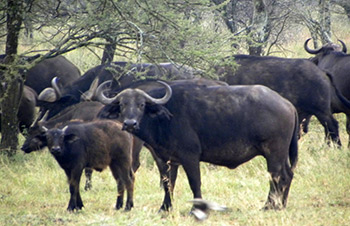 |
|
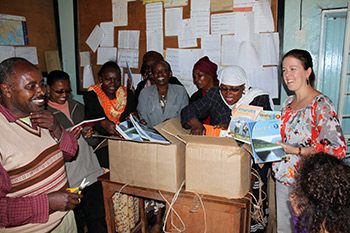 |
|
| |
Water buffalo |
|
The teachers at Kotela School in Marangu are happy with KILEO's gift of books. Shawn MIya (on the right) makes the presentation. |
|
After an icy gin and tonic, the hot drums of an African dance band entice me onto the dance floor. We find out later that Walter has been spiking his bottled water with a potent local brew. Walter dances like a wild man, kicking his long legs askew, and whipping those ‘dreads” I am unable to keep up with him, yet it’s great fun to try.
Over time, Billy tells me more about his adventures with Walter. “He talks me into paying large amounts of money to climb some mountain I’m not capable of climbing. He gets me way up on the mountain—where I get sick—then he goes on to the top. He always says, ‘I’m never going to do this again,’ but he always does. So I keep goin’ along with him!”
As travel buddies, Billy and Walter have always shared things, whether it’s money or food, sleeping pads or a pitcher of beer. When they travel around Tanzania, Billy recalls, they often run into Walter’s friends, relatives or colleagues. They came upon one cousin on a crowded Lake Victoria ferry, another cousin while walking through a cornfield.
“It’s like traveling with a rock star,” Billy explains. “People know Walter wherever he goes.”
Now that Walter and his family have moved to Tanzania, Billy believes Safari Arts Expeditions will be much more successful. While Safari Arts Expeditions keeps on growing, Billy’s keen appetite for adventure will help keep this family business alive.
|
|